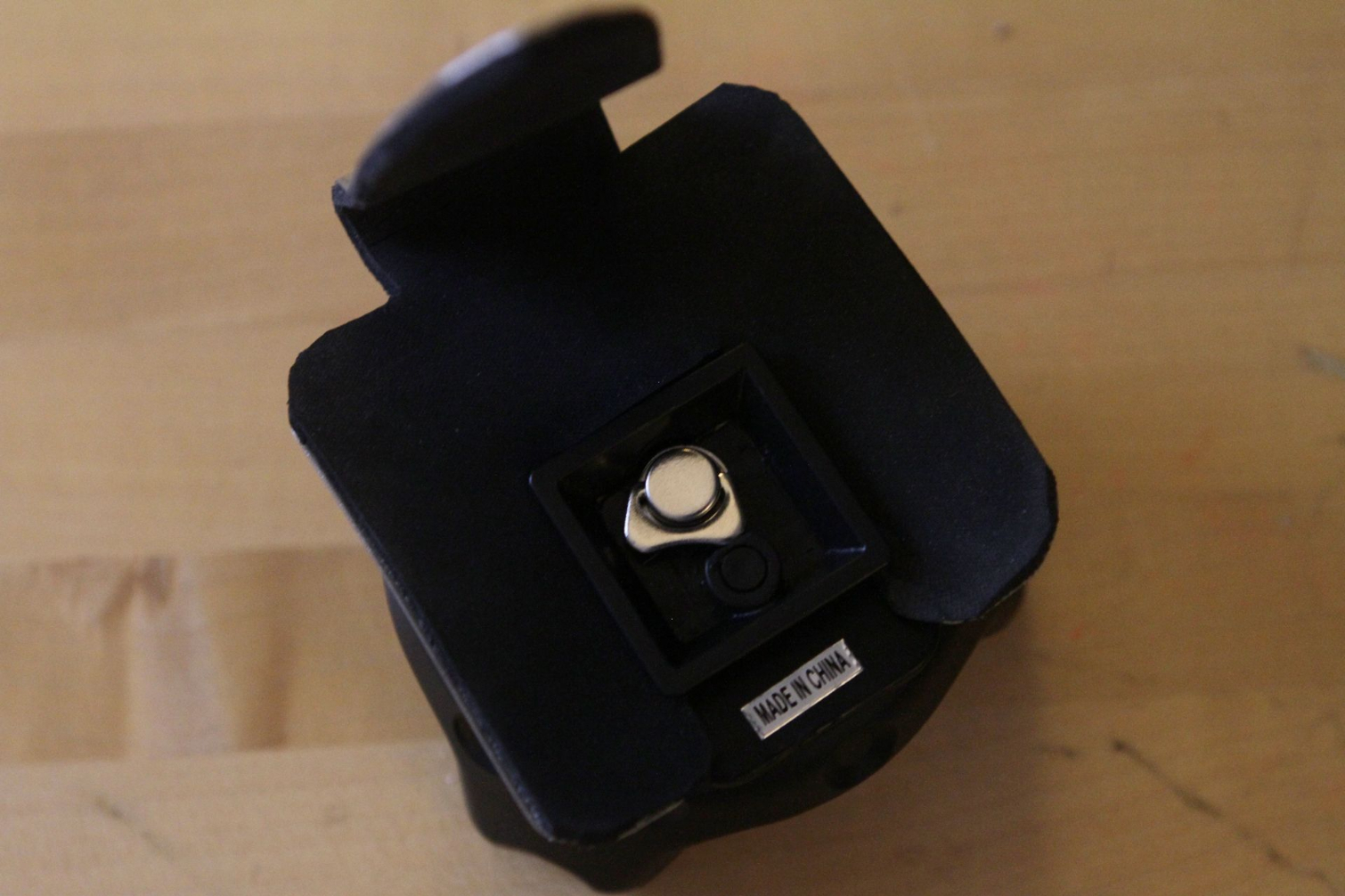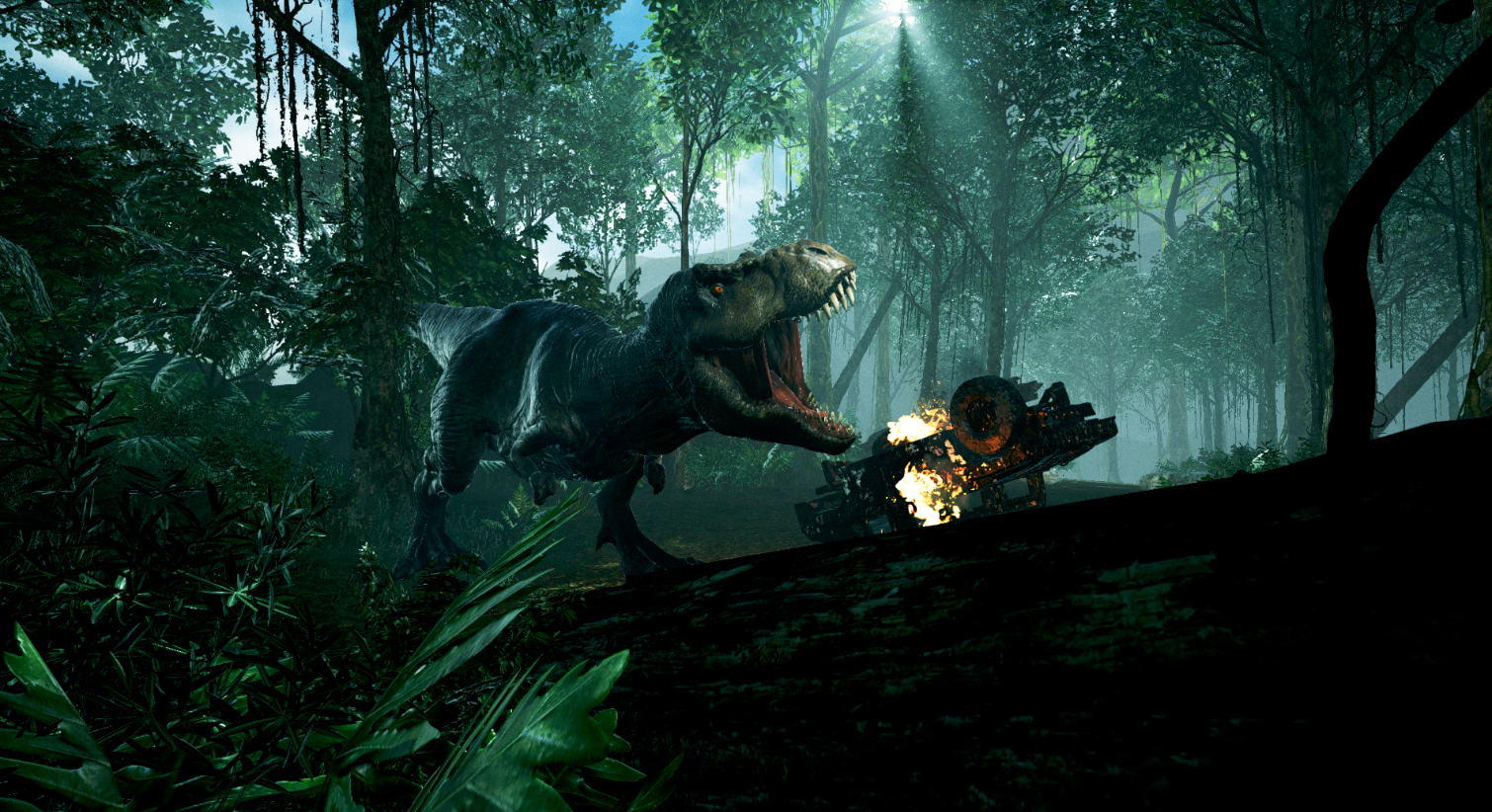Kicking Dinos To Death With HTC Vive Trackers
We’ve fought our way through a terrifying island of dinosaurs before in Cloudgate Games’ Island 359, but at GDC, the developers added full-body tracking (sort of) using three HTC Vive trackers. We revisited the island, and this time we brought another weapon: Our tracked feet, with which we curb stomped a bunch of dinos into oblivion.
MoCap Come True
Steve Bowler and Jeremy Chapman of Cloudgate Games have backgrounds in motion capture (mocap), and they’ve brought that expertise to bear on Island 359using the HTC Vive Trackers--three of them, to be exact.
They attached one tracker each to my feet, and one behind me (on my belt). With two fistfuls of HTC Vive controllers and of course the tracked Vive HMD itself, the devs have six points of tracking. As we saw with mocap solutions like Noitom’s Perception Neuron, the more trackers the better, but Cloudgate has made do with just the six. They fill in the gaps between the tracked points with estimations and renders of appendages, so you end up with an entire body. It’s just an avatar, but you look like a person--not a “real” person, but certainly a “video game” person--but in any case, it’s not a silly cartoon or a detail-less blue daemon.
In the training room of the game, you can choose between a male or female avatar, but there’s just one of each--you don’t look like a representation of yourself. However, in the training room mirror, you can see your entire virtual body. You can watch yourself move your hands, arms, legs, head, and hips around quite naturally.
The tracking did have some issues. (This was not unexpected; Bowler and Chapman told us that we were using a pre-alpha version, so we expect the issues to go away in later builds.) For example, my avatar’s elbows stuck out even when my hands were at my sides. They noted that this is because of my height; they’d been demoing most recently with shorter people, and merely by being 6’2”, I wrecked the demo. Further, sometimes the trackers would lose themselves a little, and my limbs would extend or bend or distort in horrifying ways. (My virtual limbs, that is; my actual limbs were fine.)
In some instances, the lost tracking seemed to happen “just because,” especially when I was moving around a lot. However, one of the issues with the Vive Trackers (and really any body-mounted motion tracker) is that excess vibrations make them lose tracking.
This a problem that Cloudgate is working on. Really, it’s a physical and practical one. You need snug, strong clips to keep the trackers from bouncing around as your stomp your feet.
Get Tom's Hardware's best news and in-depth reviews, straight to your inbox.
About Those Clips
Speaking of the clips, this is an area where Cloudgate is leaning in. The devs created their own code within Unreal Engine that makes the magic work, but they also hand-crafted prototype clips. They made the bendy-but-firm sheet metal clasps from off-the-shelf parts from a hardware store.
For now, they’re lined with rubber to protect your shoes and belt. A more finalized version will be substantially different, with plastic parts and an alligator clip design.
One feature of the current clip prototype that will likely remain is a clever--we’re not sure what to call it, a nubbin?-- that keeps the Vive Trackers securely attached to the clips. The trackers have a basic camera tripod thread mount, so it’s easy enough to screw them into anything that has the matching screw post. However, the mounted device can rotate on the mount all too easily. This is a no-go for a mount that has to endure human kicking. So Cloudgate added a little meta nubbin to prevent rotation and keep the trackers firmly in place. (Patents are pending.)



Bowler and Chapman demurred when we asked if they would be charging for their mocap code; we suspect they’ll ultimately consider it a donation to the field, although they may go the licensing route. Really, it seems their priorities are 1) to make their own games more immersive and enjoyable with body tracking and 2) sell the clips. They shouldn’t cost too much; we would expect them to be under $20.
Dino Stomp (And Stab And Shoot And Slash)
For as wonky as the tracking was in the training room, it was much better in-game. My limbs remained the correct lengths and shapes, and, of note, I felt as though I was my actual height throughout. (One of the more cloying ways of losing immersion is when you’re in VR and suddenly feel far shorter or taller than you actually are.)
When you look down at yourself in Island 359, you can see your own body, including your legs and feet. This is, of course, an ideal feature, and one that we unfortunately rarely see in VR.
Even so, given the limitations of locomotion in this and most other VR titles (Island 359 uses teleportation), having tracked feet and torso were of limited value. What was delightful, though, was that my feet became a new weapon in my dinosaur-hunting quiver. You get handguns, machine guns, knives, and axes, and you can switch between them at any time. The non-projectile weapons are of course best for melee attacks, but I found that my feet did damage, too. In fact, in some instances, my feet were my best melee weapon, because the knives and axes break right away when you whack a larger dinosaur. In the midst of a raptor feeding frenzy, it’s hard to have the presence of mind to switch out your broken blades for guns, but what is quite natural when otherwise weaponless is to kick like a maniac. Which I did.
The little ankle-biting dinosaurs that attack you will croak in bloody fashion with a swift kick or stomp. It appears you can damage the raptors with kicks, and you can possibly kill them that way, but it takes long enough to do so that the dino would probably eat your face before kicking the bucket.
You can’t damage the larger beasts, like the T-Rex and tricertops, with your feet, but a good foot melee will slow them down and buy you a little time to load up your guns.
This is the part of the article where we point out that for as compelling as full body tracking may be, the Vive Trackers jack the total cost of the VR rig up significantly. You already need a higher-end PC, plus the $800 Vive with controllers, and at $100 a pop, the three Vive Trackers add another 300 bucks to the bill. That’s $1,100 just for the Vive and accessories. You also have to buy the game.
That’s not cheap, but Cloudgate does have the advantage of using Vive gear for its mocap solution, so at least they’re in a well-supported ecosystem.
The main takeaway here, though, is that Cloudgate Games is closing up one of the many gaps in VR immersion. There are many such gaps that, for now, most of us have accepted as part of the deal; being unable to see a virtual facsimile of your body in VR is definitely one of them, and being able to naturally use parts of your body to interact with a VR experience is another. With its body tracking and the Vive Trackers, Cloudgate is looking to bridge both.
As we mentioned, what Bowler and Chapman have right now is a pre-alpha build, but it functions well enough that the rest of the field should take notice.
Seth Colaner previously served as News Director at Tom's Hardware. He covered technology news, focusing on keyboards, virtual reality, and wearables.
-
Jeff Fx Want.Reply
So many games become possible with foot trackers. From jumping platformers to sports games. -
John Nemesh If there is more than a single game (very, VERY likely) that support multiple trackers, I will buy a few! Hell, I am already in it for $2800 (PC + Vive), what's another $300?Reply -
kcarbotte Reply19365982 said:If there is more than a single game (very, VERY likely) that support multiple trackers, I will buy a few! Hell, I am already in it for $2800 (PC + Vive), what's another $300?
I think that's what Valve/HTC are banking on with the accessory ecosystem.
I think it will eventually be pretty common for Vive owners to have two or three trackers and an array of accessories for them, such as these foot and belt clips and the various guns we've seen.
Someone really into shooters might consider picking up a Rifle, one or two pistols, and maybe a shotgun peripheral to cycle through. I could even see a generic mele-type weapon that could be used to mimic swords, crowbars, or chainsaws.
So much possibility. Especially for VR arcades.
-
grimfox I'm surprised no one has tried using an external array like a Kinect2.0 for body tracking. Combining the wand and headset data with even a rough body position feedback could really be far more effective and cheaper solution. As opposed to buying half a dozen trackers.Reply -
kcarbotte Reply19369484 said:I'm surprised no one has tried using an external array like a Kinect2.0 for body tracking. Combining the wand and headset data with even a rough body position feedback could really be far more effective and cheaper solution. As opposed to buying half a dozen trackers.
actually, someone is experimenting with that idea.
https://www.youtube.com/watch?v=3OYY5n4U4JA

